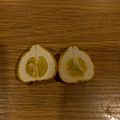Trifoliate orange facts for kids
Quick facts for kids Trifoliate orangeCitrus trifoliata or Poncirus trifoliata (syn.) |
|
|---|---|
 |
|
| A fruiting tree in Jardin des Plantes, Paris | |
| Scientific classification | |
| Kingdom: | |
| (unranked): | |
| (unranked): | |
| (unranked): | |
| Order: | |
| Family: | |
| Subfamily: |
Aurantioideae
|
| Tribe: |
Citreae
|
| Genus: | |
| Species: |
C. trifoliata
|
| Binomial name | |
| Citrus trifoliata |
|
| Synonyms | |
|
|
The trifoliate orange is a special kind of plant. Its scientific names are Citrus trifoliata or Poncirus trifoliata. It belongs to the Rutaceae family, which includes all citrus fruits. This plant is unique among citrus because it loses its leaves in winter. Its leaves also have three parts, and its fruits have a soft, fuzzy skin.
People also call it the Japanese bitter-orange, hardy orange, or Chinese bitter orange. It comes from northern China and Korea.
This plant is quite good at handling cold weather. It can even survive some frost and snow. It grows into a large shrub or a small tree, usually about 4 to 8 meters (13 to 26 feet) tall. Because it's so tough, other citrus plants are often grown on its roots. This makes them stronger and more resistant to cold.
Contents
Discovering the Trifoliate Orange
What Does the Plant Look Like?
The trifoliate orange is easy to spot. It has large thorns, about 3 to 5 centimeters (1 to 2 inches) long, on its branches. Its leaves fall off in winter, and each leaf usually has three small parts. The middle part is about 3 to 5 centimeters long, and the two side parts are 2 to 3 centimeters long.
Flowers and Fruits
The flowers are white and have pink parts inside. They are about 3 to 5 centimeters across, which is bigger than flowers on regular citrus trees. They look like other citrus flowers but don't smell as strong. If you crush the leaves, they give off a spicy smell, just like other citrus leaves.
The fruits start green and turn yellow when they are ripe. They are about 3 to 4 centimeters wide, similar in size to a lime. They look like small oranges but have a fuzzy surface, almost like a peach. The fruits also have a unique smell and often contain many seeds.
How People Use Trifoliate Oranges
Growing and Cultivating the Plant
One special type of trifoliate orange is called 'Flying Dragon'. It stays small and has twisted, curvy stems. It makes a great fence or barrier because it grows very thick and has strong, curved thorns. These thorny fences are so strong that they have been used for over 50 years at Oklahoma State University to keep students from cutting through certain areas! Deer also tend to stay away from this plant. You can even see mature trifoliate orange plants growing in the gardens of St Paul's Cathedral in central London.
The trifoliate orange and its mixed types are often used as "rootstock" for other citrus plants. This means the roots of the trifoliate orange are used to grow other citrus trees on top. This helps the other citrus trees grow stronger and resist diseases. For example, studies show that trifoliate oranges have a special chemical called auraptene. This chemical helps protect them from a plant disease called citrus tristeza virus (CTV).
Using the Fruit as Food
The fruits of the trifoliate orange are very bitter. This is because they contain a substance called poncirin. Most people find them too bitter to eat fresh. However, they can be used to make marmalade, a sweet and tangy spread. When the fruits are dried and ground into a powder, they can also be used as a condiment to add flavor to food.
Traditional Medicine Uses
In traditional medicine practices in East Asia, the fruits of the trifoliate orange are used. They are believed to help treat allergic inflammation, which is when your body reacts strongly to something it doesn't like.
About Its Scientific Name
How Scientists Classify It
For a long time, scientists debated if the trifoliate orange should be in its own group (genus) called Poncirus, or if it should be part of the Citrus genus with other oranges and lemons.
One scientist, Walter Swingle, decided to put it in its own genus, Poncirus. He did this because its leaves are different from other citrus plants. However, other scientists, like David Mabberley, later put it back into the Citrus genus.
Newer studies looking at the plant's DNA have shown different things. Some studies suggest it fits within Citrus, while others say it's different enough to be its own genus. It's a bit like a family tree with some branches that are hard to place!
Hybrids and New Varieties
The trifoliate orange doesn't usually mix with other citrus plants naturally. This is because they flower at different times of the year. But scientists have created new plants by crossing the trifoliate orange with other citrus types.
For example, a "citrange" is a mix between the trifoliate orange and a sweet orange. A "citrumelo" is a mix of the trifoliate orange and a 'Duncan' grapefruit. These mixed plants are often hardier, thanks to their trifoliate orange parent.
See also
 In Spanish: Naranjo espinoso para niños
In Spanish: Naranjo espinoso para niños





